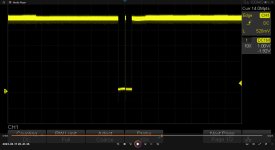OK wow, this is encouraging.
The BA0-BA15 lines are each half the frequency of the preceding one at TTL levels. I measured them on the 74LS244s.
The Decoder has good TTL signals on the outputs but I don't have a logic analyzer, nor have I used one in a few decades, so I can't say they are valid based on the inputs.
The ROM chip selects all look OK to me except UD7 that looks like it is selected twice (Or has a brief 5v peak in the middle of the select). This is an unpopulated socket because the chip was rusty and a pin fell off

UD11 and 12 are also unpopulated, as they were when I got the machine.
I am a bit confused on the RAM, aren't /RAS and /CAS the refresh lines? They do have good TTL levels.
The Din and Dout lines are tied together on the schematic !?! They have bus contention but I am guessing we are not there yet.
For the video RAM buffers, which is the read side? relative to the RAM so the ESD0-7? They look fine, the other side is not so hot.
It is a bit late so I plan to recheck these, and record the scope readings in the morning
I got the first coat of primer on the CRT chassis today so I am hoping to be ready to put a tube in this beast by Sunday. Tomorrow is supposed to be in the 60s for more primer and paint.
Mike


